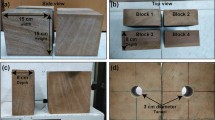Abstract
Sudden and unexpected collapses of underground cavities below the city of Naples (Italy) represent a serious safety hazard. The collapses occur due to the detachment of large blocks from the cavity roofs, walls and pillars, often a long time after the original quarry excavation has been completed. It is recognised that existing discontinuities, e.g., fractures, play an important role in the failure process by inducing local stress-concentrations and reducing the overall material strength. The larger fractures, which ultimately lead to collapse occur through interaction, propagation and coalescence of these discontinuities. This paper presents recent results of experiments carried out on natural, dry specimens of Neapolitan fine-grained tuff to investigate the mechanisms involved in sample failure. A better understanding of fracture development and rock bridge behaviour is gained through a combination of AE and photographic monitoring in an experimental program considering samples with artificial pre-existing heterogeneities, which simulate the in situ discontinuities. For a range of rock bridge geometries the mechanisms and timing of different stages of the failure process are identified and characterised. The results show that, in general, a classical description of failure, for samples without artificial flaws or with only a single flaw, is followed: (1) crack closure; (2) linear stress-strain response and crack initiation with stable crack growth; (3) crack damage and unstable crack growth leading to failure. For samples with two artificial pre-existing flaws the third phase is split into two parts and failure of the sample occurs only after both the unstable propagation of external wing cracks and coalescence of the internal cracks in the bridge. In terms of the timing and duration of each phase, it is seen that phases 1 and 2 have little dependence on the flaw configuration but phase 3 seems to depend directly on this. In particular the angle in rock bridge between the inner tips of the pre-existing flaws, β, plays a key role: phase 3 is shorter for β = 120° than for β = 105°. These differences are due to the different modes of coalescence in the rock bridge. For β = 105° the total failure is preceded by bridge rotation, which appears to take longer than the simpler mode of failure for β = 120°. It has only been possible to determine the time ranges of interest using the AE signatures, whilst the photographs allow the fracture geometry evolution to be described. Additionally the frequency character of AE events is investigated and shown to have significant potential for characterisation of AE source types and thus failure processes.
Similar content being viewed by others
Author information
Authors and Affiliations
Corresponding author
Rights and permissions
About this article
Cite this article
Hall, S.A., Sanctis, F.d. & Viggiani, G. Monitoring Fracture Propagation in a Soft Rock (Neapolitan Tuff) Using Acoustic Emissions and Digital Images. Pure appl. geophys. 163, 2171–2204 (2006). https://doi.org/10.1007/s00024-006-0117-z
Received:
Revised:
Accepted:
Issue Date:
DOI: https://doi.org/10.1007/s00024-006-0117-z




